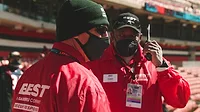Guarding Against 'Dirty Bombs' and Other Radiation Weaponry

Sports venues for many years have been on the lookout for weapons like guns and knives at their entrance ways, and it would probably be very difficult for a bad actor to enter a stadium with a nuclear warhead. But other types of weaponry that emits radiation, such as so-called “dirty bombs,” are more difficult to detect.
That’s where equipment from a company like Thermo Fisher Scientific, based in Waltham, Mass., comes into play, says Scott Masiella, global safety and security market manager. “You pack a non-fissionable isotope like cesium, put an explosion next to it and make it an airborne particle, and people get radiation sickness,” he says. “The cleanup is going to be fairly expensive and take a long time. That’s probably the No. 1 thing that users of our equipment who monitor stadiums and sporting events are most concerned about.”
If the Boston Marathon bombers had used cesium instead of nails, the immediate impact wouldn’t have been as obvious, but longer-term it would have been worse, Masiella says. “We wouldn’t have seen as much blood and gore, but we would have seen more fatalities after the fact,” he says. “They would have thought it was a regular explosive, they would have breathed in the particles, and that’s when they would have gotten sick – when you have radioactive particles sitting on your vital organs.”
Thermo Fisher’s equipment needs to be sensitive enough to know when it’s detecting a dirty bomb and when it’s detecting something else completely innocent. Certain medical treatments set off an initial alarm, “so we have to have a piece of equipment that can decipher those and allow the medical patient to pass through without a big investigation,” Masiella says.
At the Super Bowl last year in New York City, for example, the company supported NYPD in a two-step process that involved casting a wide net in the “pile of parking lots” around Met Life Stadium and then homing in on people who alarmed the equipment with the more sensitive personal radiation detectors near the entrances, he says.
A more recently released product from Thermo Fisher, the RadEye SPRD-GN, which came out in November, combines both functions into the same piece of equipment, Masiella says. “Never before have we had something that could do that in such a small device,” he says. “It’s helped a lot in terms of cutting down on the number of tools people have to carry.”
Read more about Growing Terrorism Threats Lead Sports Security Leaders to Change Tactics.
Looking for a reprint of this article?
From high-res PDFs to custom plaques, order your copy today!





